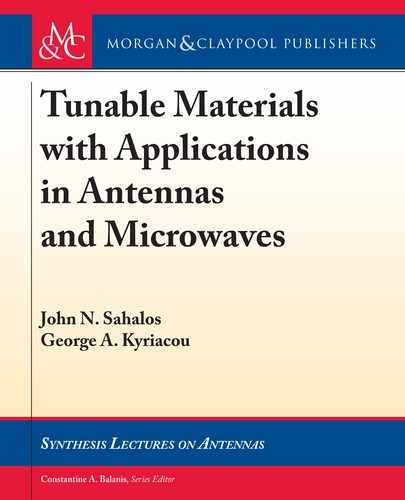58 2. TUNABLE MATERIALS–CHARACTERISTICS AND CONSTITUTIVE PARAMETERS
are shown in Figures 2.28a and b, respectively. e latter, (Figure 2.28b, ı D 0), presents the
highest conductivity, while for ı D 0:6 to 0.8, a transition occurs and the material ceases to be
a superconductor. It should also be noted that the superconducting properties in YBCO are in
general anisotropic. In addition, the critical transition temperature of YBCO from a normal to
a superconducting state is 93 K. is temperature can be provided by liquid nitrogen that has a
boiling point at 77 K.
2.19 FERROELECTRIC LAYERS AND ELECTRODE
INTERFACES
In practical applications, a ferroelectric material is either sandwiched between two electrodes
to form a tunable capacitor or grown (e.g., as a thin epitaxial film) on the top of a grounded
substrate (with a grounded electrode on its bottom side) in order to realize the printed mi-
crowave circuit (see Figure 2.29). In the latter case, the electrode may be manufactured, often
using electron beam evaporation techniques, either on top of a superstrate or directly on top
of the ferroelectric. Phenomena of great importance occur at the following interfaces: ferro-
electric/electrode, substrate/electrode, and ferroelectric/substrate (dielectric or ferrite garnet).
e formation of a thin layer with different characteristics between a metallic electrode and the
dielectric substrate is a well-known phenomenon occurring across the whole frequency spec-
trum. At the very low frequency range, this parasitic layer presents high impedivity, (high re-
sistivity) [44]. At the electrode/ferroelectric interface, a thin layer of a low dielectric constant
is formed at the ferroelectric side, which substantially degrades ferroelectric permittivity. Ac-
cording to [40], the direct growth of a ferroelectric thin film on a noble metal electrode (Au,
Pt) should be avoided. is is because it causes the degradation of ferroelectric features even
though its conductivity (when operated at room temperature) is higher than that of the pref-
erential metallic oxide electrodes. is degradation is due to a Schottky barrier built up at the
metal-ferroelectric interface, which is mainly caused by the difference in the work functions of
the two media. Moreover, the height of the barrier depends on electron affinity, the density
of the charge carriers in the ferroelectric, and the density of the states at the interface. Well-
known metallic oxide electrodes, compatible and well matched with ferroelectrics like SrTiO
3
or BSTO, are the superconductor YBCO or the ruthenate superconductors SRO (SrRuO
3
),
LSMO (La
2/3
Sr
1/3
MnO
3
), and LCMO (La
2/3
Ca
1/3
MnO
3
). However, the high resistivity of
these metallic oxide electrodes yields high microwave losses. A solution to this problem is the
use of the metallic oxides as buffer-matching layers between ferroelectrics and noble metal elec-
trodes as shown in Figure 2.29. A very promising structure offering good film quality, high
degree of tunability, and low microwave losses is Au/Pt/BSTO/SRO/Pt/Au [40].
A block diagram of the low-temperature co-fired ceramic (LTCC) technology is analyti-
cally presented in Figure 2.30.
e goal set for the epitaxial growth of the above multilayer thin films is to achieve prop-
erties as good as those of single crystal bulk materials do. To this purpose, the layers with a
..................Content has been hidden....................
You can't read the all page of ebook, please click here login for view all page.
